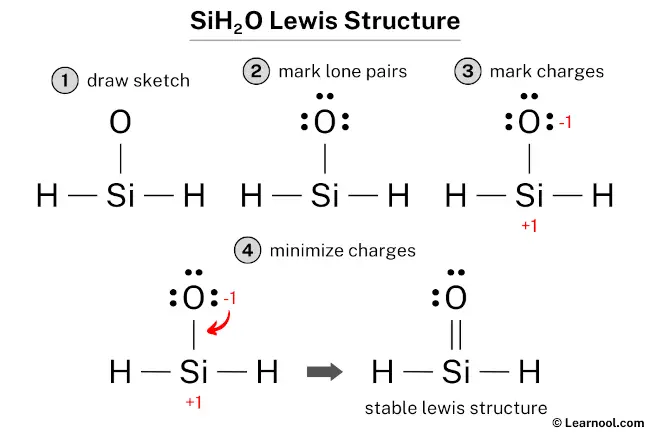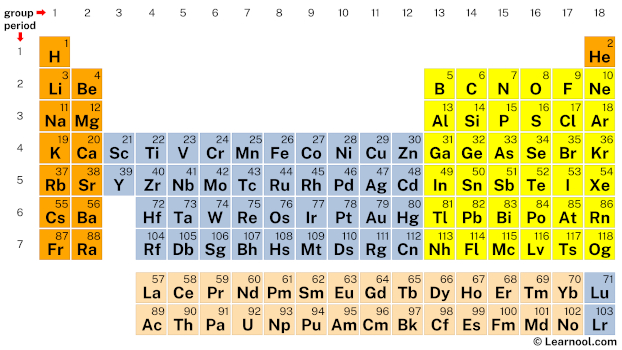
SiH2O has one silicon atom, two hydrogen atoms, and one oxygen atom.
In SiH2O Lewis structure, there is one double bond and two single bonds around the silicon atom, with one oxygen atom and two hydrogen atoms attached to it. And on the oxygen atom, there are two lone pairs.
Steps
Here’s how you can easily draw the SiH2O Lewis structure step by step:
#1 Draw a rough skeleton structure
#2 Mention lone pairs on the atoms
#3 If needed, mention formal charges on the atoms
#4 Minimize formal charges by converting lone pairs of the atoms, and try to get a stable Lewis structure
#5 Repeat step 4 again if needed, until all charges are minimized
Now, let’s take a closer look at each step mentioned above.
#1 Draw a rough skeleton structure
- First, determine the total number of valence electrons

In the periodic table, silicon lies in group 14, hydrogen lies in group 1, and oxygen lies in group 16.
Hence, silicon has four valence electrons, hydrogen has one valence electron, and oxygen has six valence electrons.
Since SiH2O has one silicon atom, two hydrogen atoms, and one oxygen atom, so…
Valence electrons of one silicon atom = 4 × 1 = 4
Valence electrons of two hydrogen atoms = 1 × 2 = 2
Valence electrons of one oxygen atom = 6 × 1 = 6
And the total valence electrons = 4 + 2 + 6 = 12
Learn how to find: Silicon valence electrons, Hydrogen valence electrons, and Oxygen valence electrons
- Second, find the total electron pairs
We have a total of 12 valence electrons. And when we divide this value by two, we get the value of total electron pairs.
Total electron pairs = total valence electrons ÷ 2
So the total electron pairs = 12 ÷ 2 = 6
- Third, determine the central atom
Here hydrogen can not be the central atom. Because the central atom is bonded with at least two other atoms, and hydrogen has only one electron in its last shell, so it can not make more than one bond.
Now we have to choose the central atom from silicon and oxygen. Place the least electronegative atom at the center.
Since silicon is less electronegative than oxygen, assume that the central atom is silicon.
Therefore, place silicon in the center and hydrogen and oxygen on either side.
- And finally, draw the rough sketch

#2 Mention lone pairs on the atoms
Here, we have a total of 6 electron pairs. And three bonds are already marked. So we have to only mark the remaining three electron pairs as lone pairs on the sketch.
Also remember that silicon is a period 3 element, so it can keep more than 8 electrons in its last shell. Hydrogen is a period 1 element, so it can not keep more than 2 electrons in its last shell. And oxygen is a period 2 element, so it can not keep more than 8 electrons in its last shell.
Always start to mark the lone pairs from outside atoms. Here, the outside atoms are hydrogens and oxygen. But no need to mark on hydrogen, because each hydrogen has already two electrons.
So for oxygen, there are three lone pairs, and for silicon, there is zero lone pair because all three electron pairs are over.
Mark the lone pairs on the sketch as follows:

#3 If needed, mention formal charges on the atoms
Use the following formula to calculate the formal charges on atoms:
Formal charge = valence electrons – nonbonding electrons – ½ bonding electrons
For silicon atom, formal charge = 4 – 0 – ½ (6) = +1
For each hydrogen atom, formal charge = 1 – 0 – ½ (2) = 0
For oxygen atom, formal charge = 6 – 6 – ½ (2) = -1
Here, both silicon and oxygen atoms have charges, so mark them on the sketch as follows:

The above structure is not a stable Lewis structure because both silicon and oxygen atoms have charges. Therefore, reduce the charges (as below) by converting lone pairs to bonds.
#4 Minimize formal charges by converting lone pairs of the atoms
Convert a lone pair of the oxygen atom to make a new Si — O bond with the silicon atom as follows:

In the above structure, you can see that the central atom (silicon) forms an octet. The outside atom (oxygen) also forms an octet, and both hydrogens form a duet. Hence, the octet rule and duet rule are satisfied.
Therefore, this structure is the stable Lewis structure of SiH2O.
Next: OF3– Lewis structure
External links
Deep
Learnool.com was founded by Deep Rana, who is a mechanical engineer by profession and a blogger by passion. He has a good conceptual knowledge on different educational topics and he provides the same on this website. He loves to learn something new everyday and believes that the best utilization of free time is developing a new skill.
